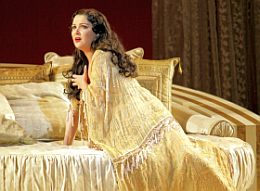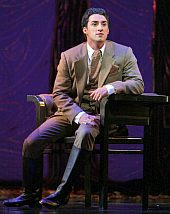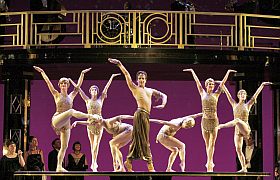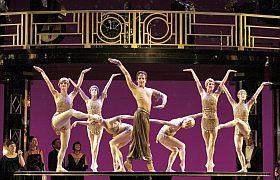
Photos by Cory Weaver
On opening night, Saturday, Anna Netrebko was superb as the courtesan Violetta Valéry, easily adapting to the updating of the opera from Second Empire France to Roaring Twenties America. Her theatrical instincts were sure, and her capacity for quicksilver rebootings into new modalities and varied emotions was exceptional. For example, she rendered the repetitions of the same musical phrase in the first act aria “Sempre libera” (Always free) in unusually distinctive ways: first with an air of indifference to danger, then in a mood of self-destruction, next filled with contemptuous arrogance, and finally with a sense of dread. As she fought to escape the reality of her dooming illness, she flung her frail body with ever-greater frenzy into her life of abandon — yet not without a chilling foreboding.
Netrebko’s sculptural approach to the musical phrasing is informed by her natural understanding of the character she depicts, and buttressed by her assured vocal abilities. The voice is voluptuous and balanced in all registers, with a fascinatingly complex range of vocal colors. This is a soprano with grande abbandono in her forte notes, and a genuine pianissimo that’s natural to her voice — not a fake falsetto requiring a shift into another gear. Over the years the voice has grown richer and more powerful. The lower register has acquired a dark, Slavic hue. I hope the temptation to accent this sensual register will not lead to an unbalancing of her magnificent voice.
She and conductor Donald Runnicles wove the poetry and music in Verdi’s score back and forth from stage to pit in perfect rapport. Sensitive to every rumbling of the inner psyche of the music, Runnicles joined Netrebko in this delicate creative collaboration. His prelude did not seem to foretell the plot in the usual way, but evoked, as in a distantly remembered dream, a forgotten deep melancholy. Runnicles used pianissimo not simply to soften the dynamic, but also as a deepening of the meaning. During his years with the San Francisco Opera, he has given us profound interpretations of many works — who can forget his Tannhäuser? — encompassing the momentous as well as the subtle. Here again in La traviata he evokes searing emotions.
Putting Others in the Shade
Given the two extraordinary talents of Runnicles and Netrebko, it would be hard for anyone else to shine forth. The tenor, Charles Castronovo (playing the role of Alfredo Germont), has a lovely, Italianate color marked by appealing and carefully studied phrases. Seemingly more
as Alfredo Germont
An announcement was made before the start of the opera that Croft was suffering from sinusitis. This illness may have caused a preoccupation solely with tone quality, and while the sound was well-focused, it may have been this preoccupation that rendered the character deficient in the emotional dimension needed for a successful rendition of the pivotal Act 2 duet. Renée Tatum (Annina) sang with a voice of great presence, while Leann Sandel-Pantaleo brought the opening of Act 3 to life with her portrayal of the brazen courtesan, Flora. As the Baron Douphol, Dale Travis gave a stellar performance.

While the shared opulence of the Second Empire and the Roaring Twenties provides appealing production design for the current staging, the change narrows the possibilities of dramatic characterization for Violetta. As Virginia Rounding writes in her book Grandes Horizontals, “The way she walked was so imposing, with a style of such decorum and reserve, that everyone would watch her go by with a surprise mingled with admiration and respect.” A person such as this, yearning for a refined existence, can inspire far more sympathy than a 1920s, thrill-seeking flapper.
A few small details remain to be worked out: the lighting of the last act, in which the soprano disappears in the blinding glare on the bed; the awkward supertitle that elicited giggles in the death scene; and finally the Act 3 dancers, trying their best to evoke Josephine Baker moves without success — more rehearsal needed.
All in all, the evening was exciting and successful. The audience gave Netrebko a standing ovation, and cheered Runnicles, the Opera’s departing maestro.

